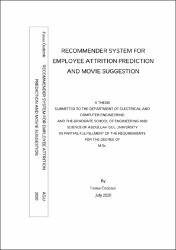| dc.description.abstract | In this thesis, we focus on two problems raised in Machine Learning Community,
namely, the recommender system and employee attrition problem. The recommender
system is an information filtering system that predicts whether users would prefer a
given item when purchasing a product. Recommender systems utilize information of
users/items to predict. These systems, especially the collaborative filtering based ones,
are used widely in E-commerce. In this work, we propose a hybrid model that combines
collaborative filtering and side-information of users/items. In the proposed model, sideinformation of users/items is utilized to find correlated neighbors and cluster them.
Then, collaborative filtering methods are applied to these clusters. The matrix
factorization and random walk with restart are implemented to evaluate the performance
of the proposed model. The proposed approach is systematically evaluated on
MovieLens data. Experimental results show that the proposed model, which uses the
side-information of the user/item, considerably improves the performance of traditional
collaborative filtering methods.
In the second part of the thesis, we try to address the employee attrition prediction
problem, which is trying to predict which persons will leave/continue a company for
which they currently work. Nowadays, it is very critical for companies to predict that
the employees will leave their jobs or not. Leaving employees, who are top performers,
may cause financial or institutional knowledge losses in the organizations. To avoid
such losses, companies have to predict employee attrition. However, the HR
departments of companies are not advanced enough to make such a prediction. To this
end, companies are using data mining methods to timely and accurately predict
ii
employee attrition. In this study, the performance of different classification methods,
such as Linear discriminant analysis (LDA), Naive Bayes, Bagging, AdaBoost, Logistic
Regression, Support Vector Machine (SVM), Random Forest, J48, LogitBoost,
Multilayer Perceptron (MLP), K-Nearest Neighbors (KNN), XGBoost, Graph
Convolutional Networks, have been presented to predict employee attrition based on
two private company datasets, i.e., IBM and Adesso Human Resource datasets.
Different from existing studies, we systematically evaluate our findings with various
classification metrics, such as F-measure, Area Under Curve, accuracy, sensitivity, and
specificity. Performance results show that data mining methods, such as LogitBoost and
Logistic Regression algorithms, can be very useful for predicting employee attrition. | en_US |


















